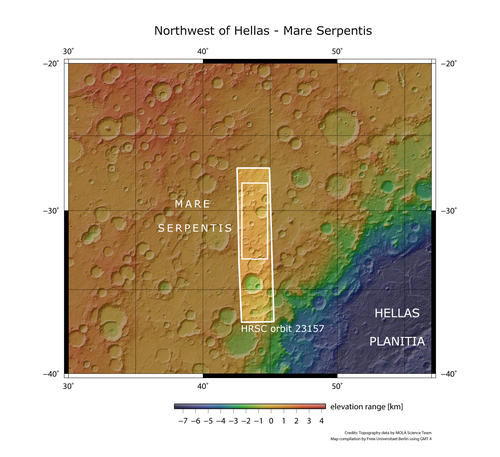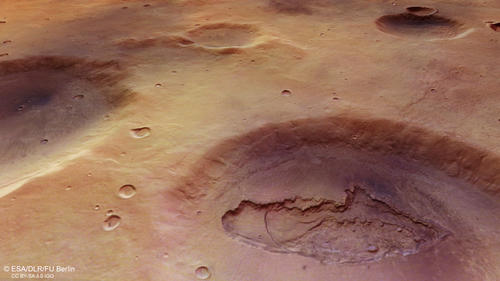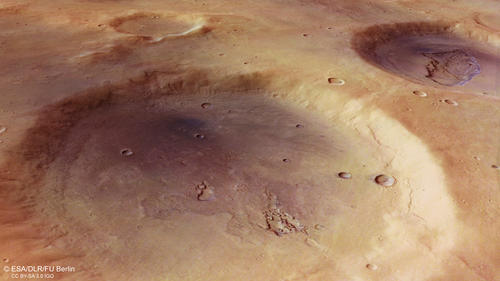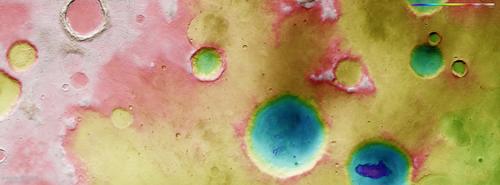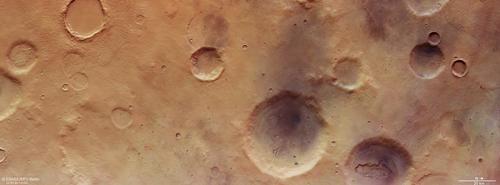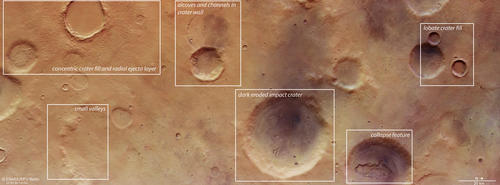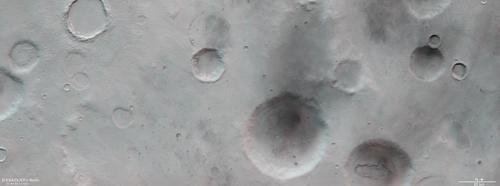Department of Earth Sciences
Service Navigation
Northwest of Hellas – Mare Serpentis Snake Pit
Image data, taken by the High Resolution Stereo Camera (HRSC) on board ESA’s Mars Express mission show a region named Mare Serpentis, located northwest of the giant Hellas impact basin. HRSC is a camera experiment that was developed and is operated by the German Aerospace Center (Deutsches Zentrum für Luft- und Raumfahrt; DLR).
» read more below the gallery
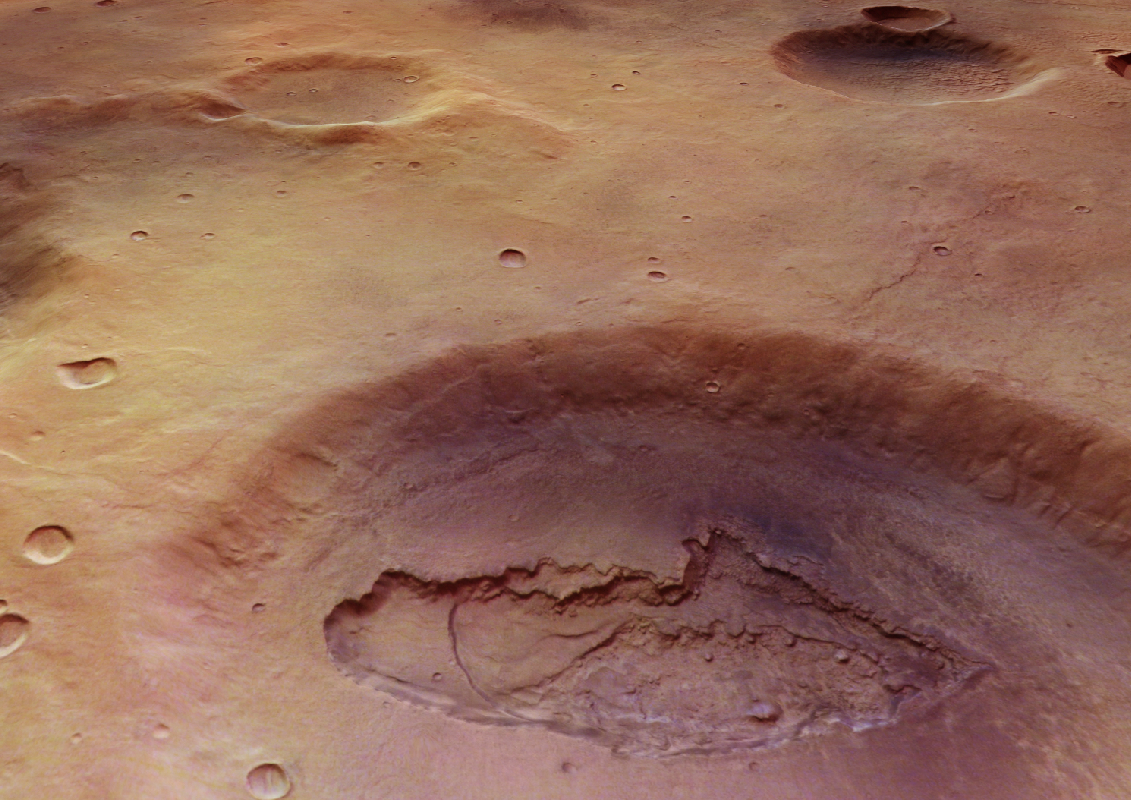
Northwest of Hellas • Position & 3D view
Northwest of Hellas - context map
Image Credit: MOLA Science Team/FU Berlin
Northwest of Hellas - 3D 1
Image Credit: ESA/DLR/FU Berlin
Northwest of Hellas - 3D 2
Image Credit: ESA/DLR/FU Berlin
Northwest of Hellas • HRSC images
Northwest of Hellas - HRSC color-coded terrain model
Image Credit: ESA/DLR/FU Berlin
Northwest of Hellas - HRSC color image
Image Credit: ESA/DLR/FU Berlin
Northwest of Hellas - HRSC annotated
Image Credit: ESA/DLR/FU Berlin
Northwest of Hellas - HRSC anaglyph
Image Credit: ESA/DLR/FU Berlin
Northwest of Hellas
» read more about the diverse region
The Mare Serpentis region (Latin for Sea of the Snakes) is located northwest of the giant Hellas impact basin and was named after the constellation Serpens in the northern celestial hemisphere. The observation shows impact craters of different ages, randomly distributed on the surface. The younger craters in the image show more distinct crater rims, the older ones appear much more smoothed and eroded. Especially peculiar are the different interior fillings of the craters. The surface patterns in these craters reflect the climatic conditions in which the fillings were formed, providing an insight into the history of the Martian climate.
The upper left flat-floored crater shows a distinct radial ejecta layer with many stripes and measures roughly 22 km in diameter. Compared to the other large craters, it appears to be the youngest. The smaller crater to its left still hosts some of the ejecta of the larger crater. The 22 km crater shows a so-called concentric crater fill. This is a common landform in the Martian mid latitudes (30°-60° N and S) and describes a crater filling deposit with an approximately concentric pattern. It develops when debris masses very slowly flow down along parts or all parts of the crater wall, often converging at or near the center of the crater floor. The debris is mixed with ice that condensed from the atmosphere. The smaller craters on the right side of the HRSC observation also show a ice-rich crater fill, however not concentric, but lobate. The distinct rims also indicate a younger age of these craters.
The largest impact crater in the image shows a width of 45 km, strongly eroded crater rims, a flat floor with some interesting erosional features and a very eye-catching dark color. Interestingly, all craters on the right side of the image show this dark color, presumably created by dark sands, transported by wind.
.
In the lower left part of the image, some small valleys can be spotted, leading into an ancient, nearly completely vanished impact crater (see annotated image), which indicate a past era of liquid water at the surface. In the upper central part of the image a strongly eroded impact crater also shows some little valleys leading into what remained from the crater. Below it, a crater approximately 18 km in diameter displays distinct alcoves and channels in the crater wall. The crater floor also shows a lobate filling, here in an apparently earlier stage.
In the lower right portion of the image, a 35 km impact crater gives interesting insights into the subsurface. Here, an approximately 20 km long, 9 km wide and several hundreds of meters deep pit opens and exposes different alternating layers in the subsurface. Some of the layers appear to be composed of brecciated materials. The curvilinear form of a prominent fault inside the pit suggests a formation by collapse. This kind of collapses are known to happen in volcanically active regions where ancient lava tubes or magma chambers emptied and as a consequence created voids in the underground which later collapsed. The region in and around Mare Serpentis is known to have been volcanically active in the past.
High Resolution Stereo Camera (HRSC)
» information to image origin and processing
The images were acquired by the HRSC (High Resolution Stereo Camera) on 1 May 2022 during Mars Express Orbits 23157. The ground resolution is approximately 21 meters per pixel and the image is centered at about 44° East and 30° South. The color image was created using data from the nadir channel, the field of view which is aligned perpendicular to the surface of Mars, and the color channels of the HRSC. The oblique perspective view was generated from the digital terrain model, the nadir and color channels of HRSC. The anaglyph image, which creates a three-dimensional impression of the landscape when viewed with red/blue or red/green glasses, was derived from the nadir channel and one stereo channel. The color-coded topographic view is based on a digital terrain model (DTM) of the region, from which the topography of the landscape can be derived. The reference body for the HRSC-DTM is a Mars equipotential surface (Areoid).
HRSC is a camera experiment that was developed and is operated by the German Aerospace Center (Deutsches Zentrum für Luft- und Raumfahrt; DLR). The systematic processing of the camera data took place at the DLR Institute for Planetary Research in Berlin-Adlershof. The working group of Planetary Science and Remote Sensing at Freie Universität Berlin used the data to create the image products shown here.
To download released raw images and DTMs of the region in GIS-ready formats, follow this link to the mapserver.
Images: ESA/DLR/FU Berlin, CC BY-SA 3.0 IGO
Copyright Notice:
Where expressly stated, images are licenced under the Creative Commons Attribution-ShareAlike 3.0 IGO (CC BY-SA 3.0 IGO) licence. The user is allowed to reproduce, distribute, adapt, translate and publicly perform it, without explicit permission, provided that the content is accompanied by an acknowledgement that the source is credited as 'ESA/DLR/FU Berlin', a direct link to the licence text is provided and that it is clearly indicated if changes were made to the original content. Adaptation / translation / derivatives must be distributed under the same licence terms as this publication.
The High Resolution Stereo Camera was developed at the German Aerospace Center (DLR) and built in collaboration with partners in industry (EADS Astrium, Lewicki Microelectronic GmbH and Jena-Optronik GmbH). The science team, which is headed by Principal Investigator (PI) Dr. Thomas Roatsch, consists of 52 co-investigators from 34 institutions and 11 countries. The camera is operated by the DLR Institute of Planetary Research in Berlin-Adlershof.
